Phillies Forming a Core 4

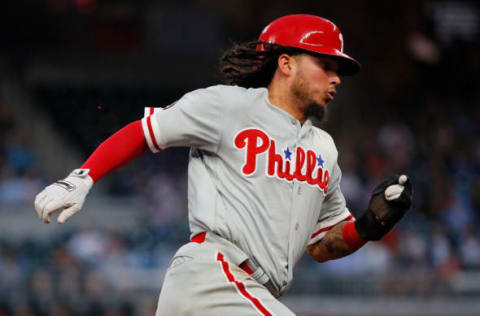
In the seasons before winning is the norm, special players emerge from the pipeline, and the front office surrounds them with a reliable cast like the Philadelphia Phillies of 1980 and 2008.
A Soft Blur:
The future like a photograph in a darkroom develops over time and comes more into focus near completion.
Since the institution of the MLB draft in 1965, one phenomenon has occurred because of clubs having early selections after losing campaigns. As a result, a handful of franchises have eventually dominated their immediate rivals with varying degrees of success regarding World Series championships, league pennants and divisional titles. Basically, the core players including the four cornerstones were the stars who were with the team during their lean years. Yet they didn’t arrive at the same time; the first summer for some with considerable visibility was a half a season after their call-up or a platoon equaling that. Ergo, Cole Hamels and Chase Utley respectively.
If you examine championship-caliber teams, the foundation always seems to be four pieces, and they’re the major contributors. For instance, those special cogs for the ’80 and ’08 Phillies were a southpaw ace, a leadoff man, a slugger and a solid hitter overall. But the portsider from the first group had come from another organization. Of course, the biggest difference was the second gang had their parade early in their run, while the original champs had accomplished their goal after years of trying.
Regarding the four potential cornerstones, this comparison is to the previous eight champions with statistics based solely on their first campaign of considerable playing time (see last page). Basically, the 1980 squad had arrived from 1970 to 1973, while the 2008 group came from 2001 to 2006. And the current viable core began in 2015.
Beginning with the “pepper pot” shortstops, Larry Bowa, Jimmy Rollins and Freddy Galvis were the first to appear in ’70, ’01 and ’15, respectively. The difference here is that Galvis doesn’t bat first, and his fieriness is behind the closed doors of the clubhouse. By comparison, Bowa’s reputation is still for chirping and will be until his fossilization, while Rollins – a “red-light” player – made headlines with his predictions. Yes, he loved the spotlight and shinned in game-on-the-line situations.
Additionally, the three shortstops were on the red pinstripes in 2014. Bowa was in his first summer as the bench coach, and Rollins was the regular shortstop in his final year as a Phillie. Meanwhle, Galvis had an injury-plagued campaign in ’14 from Opening Day to May 8 and Aug. 23 to season’s end. But keep in mind, Galvis is now the team leader.
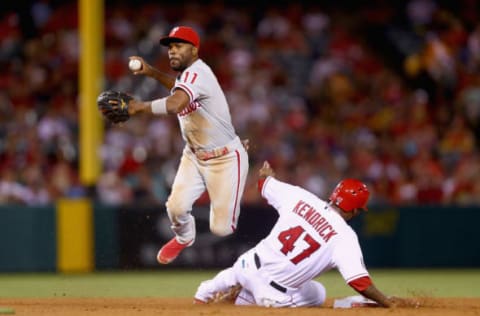
In 2001, Bowa was in his first managerial 162 locally, and Rollins was a rookie. However, when it comes to fielding, J-Roll is first in NL history with a .983 record; and Bo is second with a .980 mark for a minimum of 1,000 games. And Galvis is currently at .983 for 481 contests, and only Omar Vizquel is higher with a .985 MLB best. In fact, Galvis wears number 13 in honor of Vizquel.
During ’01, Rollins and Bowa needled each other regarding their glove work. Hey, Bowa remarked, I’d have caught it. And Rollins’ retort was no way you’d have even reached that ball, skip. Bowa’s answer: You’re just a rook!
Unlike the “father-and-son type” relationship of Bowa and Rollins, Galvis was like J-Roll’s little brother. One particular instance: Galvis was going to pinch-hit and Rollins noticed he was tight. So, he rubbed Galvis’ chest with both hands to loosen him up. And Galvis only heard c’mon, man. Stop overthinking it!
How’d they do offensively? Well, Bowa stole 39 bases in 1974, batted .305 in 1975, and drove in 49 runs in 1976. Rollins, on the other hand, reached career highs of .296 with 30 homers and 94 RBIs in 2007 plus 47 swiped bags in 2008. So far, Galvis has averaged .263 in 2015 and produced 20 long balls, 67 RBIs and 17 SBs in 2016. Currently, he’s hitting .257 with 13 pilfered bases and 57 RBIs.
FOOD FOR THOUGHT: “Physical ability only goes so far. You have to work hard the rest of the way.” – Jimmy “J-Roll” Rollins

In their heyday, Greg Luzinski and Utley were feared hitters. As the five-hole bat in the lineup, Luzinski launched 39 bombs with 130 RBIs and a .309 average in 1977: his career highs in those three categories. Utley, on the other hand, had his best years with 105 RBIs in 2005, a .332 mark in 2007 and 33 home runs in 2008. Of course, Utley slotted third in the order.
Despite the demands by many fans to demote, bench or trade Odubel Herrera, the center fielder – acquired in the Rule 5 draft – has too much talent to cast aside due to his personality. In fact, the same zest for life could help him finish in the top 10 for hitting or win a batting crown. Is there someone currently on the parent club with that potential?
So far, Herrera has highs of .297 in ’15 and 15 homers, 25 swiped bags and 49 RBIs in ’16. And his current stats are .288, 12 long balls and 48 RBIs.
ON THE OTHER HAND: “I’ve talked to guys who have played for the Phillies and gone on to other organizations and the grass isn’t always greener on the other side.” – Chase “the Silver Fox” Utley
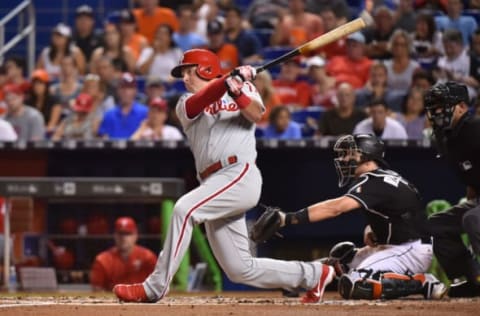
Manning corner infield positions, Mike Schmidt and Ryan Howard were the power threats. The third sacker had his big campaign in 1980 with 48 home runs and 121 RBIs. But his highest average was .316 in 1981. On the other hand, Howard’s career stats were in ’06: .313 with 58 bombs and 149 RBIs. And if you experienced those must-see Howard at-bats, you’ll definitely look forward to Rhys Hoskins in April.
WORDS OF WISDOM: “If you could equate the amount of time and effort put in mentally and physically into succeeding on the baseball field and measured it by the dirt on your uniform, mine would have been black.” – Michael Jack Schmidt
Despite currently hitting .309, Hoskins’ numbers in the high minors were eventually .284 for the Triple-A Lehigh Valley IronPigs before his call-up and .281 in 2016 for the Double-A Reading Fightin Phils. He blasted 38 long balls with 116 RBIs last season, and his current total is 41 homers with 118 RBIs. In other words, he’ll hit for a solid average and is already establishing himself as a genuine threat. Word’s out!
While many things are striking about the rookie, his plate discipline is especially intriguing. He has demonstrated patience and consistency, which equals a solid on-base percentage, and he rarely misses a pitcher’s mistake. Yes, he’s an attendance godsend.
Hoskins’ stats are through Sept. 6.
- Double-A for 2016: K% of 21.2 percent and a BB% of 12.1 percent.
- Triple-A for 2017: K% of 15.8 percent and a BB% of 13.5 percent.
- MLB for 2017: K% of 16.8 percent and a BB% of 15.0 percent.
According to Fangraphs, low walk rates are only acceptable for players with exceptional power numbers. Here are plate-discipline comparisons.
| Rating | K% | BB% |
|---|---|---|
| Excellent | 10.0% | 15.0% |
| Great | 12.5% | 12.5% |
| Above Average | 16.0% | 10.0% |
| Average | 20.0% | 8.0% |
| Below Average | 22.0% | 7.0% |
| Poor | 25.0% | 5.5% |
| Awful | 27.5% | 4.0% |
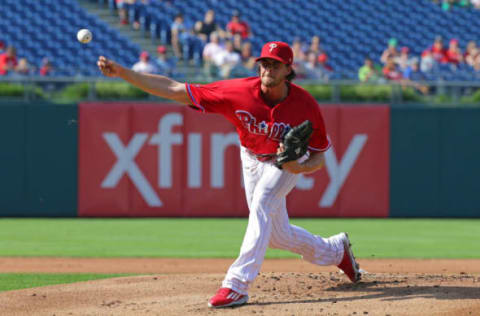
Having a stud to head the rotation is a requirement for a championship-caliber 25. And the Philadelphia Phillies had Steve Carlton and Hamels. Firstly, Carlton had his unforgettable first year in Philly of 1972: 27-10 with a 1.97 ERA and 310 punch outs. And Hamels’ best numbers were 17-6 with 216 strikeouts in 2012 and a 2.46 ERA in 2014.
ONLY YOU: “So what I did on the field was the essence of what I am. Remember me like that.” – Steve “Lefty” Carlton
Although Aaron Nola‘s 3.59 ERA for ’15 was his lowest, it was only for 13 starts over 77 2/3 innings. This season, however, he is 10-10 with a 3.72 ERA and 148 punch outs: 23 outings for 142 2/3 frames. But while these stats pale by comparison to the left-handers from the glory days, the righty produced 10 consecutive dominant performances to reveal his potential. He went 6-2 in his masterful streak with a 1.71 ERA for 68 1/3 innings.
In addition to Nola’s brilliant pitching and Hoskins’ record-setting since Aug.10, Herrera has raised his average from .217 on May 30 to .288 on Sept. 6. He is batting .341 with nine home runs and 34 RBIs from June 1 through Sept. 6: presently, 65 games with 249 at-bats. In other words, the red pinstripes have four gems: Hitting for average and power, pitching and fielding. And if – quite possible – management plugs the holes, this could be a worst-to-first team doing what the Whiz Kids didn’t do, which was? Win it all!
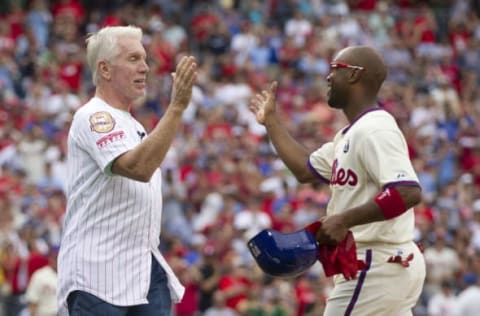
The Numerical Bible:
This review is not a sabermetrics article, which means no heavy statistical analysis. But because some readers rely on stats, this is only a reference: no reason to articulate the importance of these numbers.
Shortstops:
- Bowa, 24.5 in 1970: 145 Gms., 577 PA, a .250 Avg., a .277 OBP, a .303 SLG, a .053 ISO, a .273 BABIP, 0 HR, 34 RBI, a .580 OPS, a -0.9 fWAR, 24 SB, 13 CS and a 5.8 Spd.
- Rollins, 22.5 in 2001: 158 Gms., 720 PA, a .274 Avg., a .323 OBP, a .419 SLG, a .145 ISO, a .308 BABIP, 14 HR, 54 RBI, a .743 OPS, a 2.1 fWAR, 46 SB, 8 CS and a 7.3 Spd.
- Galvis, 25.5 in 2015: 151 Gms., 603 PA, a .263 Avg., a .302 OBP, a .343 SLG, a .081 ISO, a .309 BABIP, 7 HR, 50 RBI, a .645 OPS, a -0.2 fWAR, 10 SB, 1 CS and a 5.5 Spd.
Overall Hitters:
- Luzinski, 21.5 in 1972: 150 Gms., 611 PA, a .281 Avg., a .332 OBP, a .453 SLG, a .172 ISO, a .323 BABIP, 18 HR, 68 RBI, a .785 OPS and a 2.5 fWAR.
- Utley, 25.5 in 2004: 94 Gms., 287 PA, a .266 Avg., a .308 OBP, a .468 SLG, a .202 ISO, a .269 BABIP, 13 HR, 57 RBI, a .776 OPS and a 1.5 fWAR.
- Herrera, 23.5 in 2015: 147 Gms., 537 PA, a .297 Avg., a .344 OBP, a .418 SLG, a .121 ISO, a .387 BABIP, 8 HR, 41 RBI, a .762 OPS, a 3.9 fWAR, 16 SB, 8 CS and a 5.3 Spd.
Sluggers:
- Schmidt, 22.5 in 1973: 132 Gms., 443 PA, a .196 Avg., a .324 OBP, a .373 SLG, a .177 ISO, a .249 BABIP, 18 HR, 52 RBI, a .697 OPS and a 2.1 fWAR.
- Howard, 25.5 in 2005: 85 Gms., 348 PA, a .288 Avg., a .356 OBP, a .567 SLG, a .279 ISO, a .354 BABIP, 22 HR, 63 RBI, a .924 OPS and a 2.2 fWAR.
- Hoskins, 24.5 in 2017: 27 Gms., 113 PA, a .309 Avg., a .425 OBP, a .758 SLG, a .440 ISO, a .279 BABIP, 12 HR, 27 RBI, a 1.195 OPS and a 1.8 fWAR.
Next: Phillies Changing the Scenery
Aces:
- Carlton, 22.5 in 1967: 30 Gms. (2 in relief), 193 Inn., 14-9, a 2.98 ERA, a 2.47 FIP, a 4.4 fWAR and a 1.22 WHIP.
- Hamels, 22.5 in 2006: 23 Gms., 132 1/3 Inn., 9-8, a 4.08 ERA, a 3.98 FIP, a 3.73 xFIP, a 3.60 SIERA, a 2.6 fWAR and a 1.25 WHIP.
- Nola, 23 in 2016: 20 Gms., 111 Inn., 6-9, a 4.78 ERA, a 3.08 FIP, a 3.08 xFIP, a 3.29 SIERA, a 2.8 fWAR and a 1.22 WHIP.